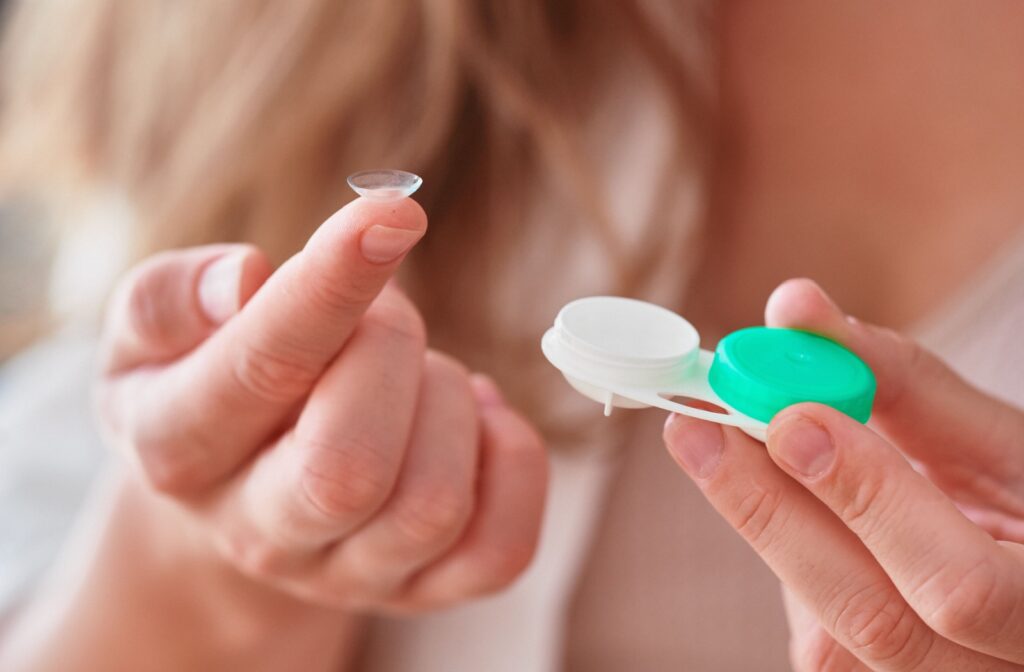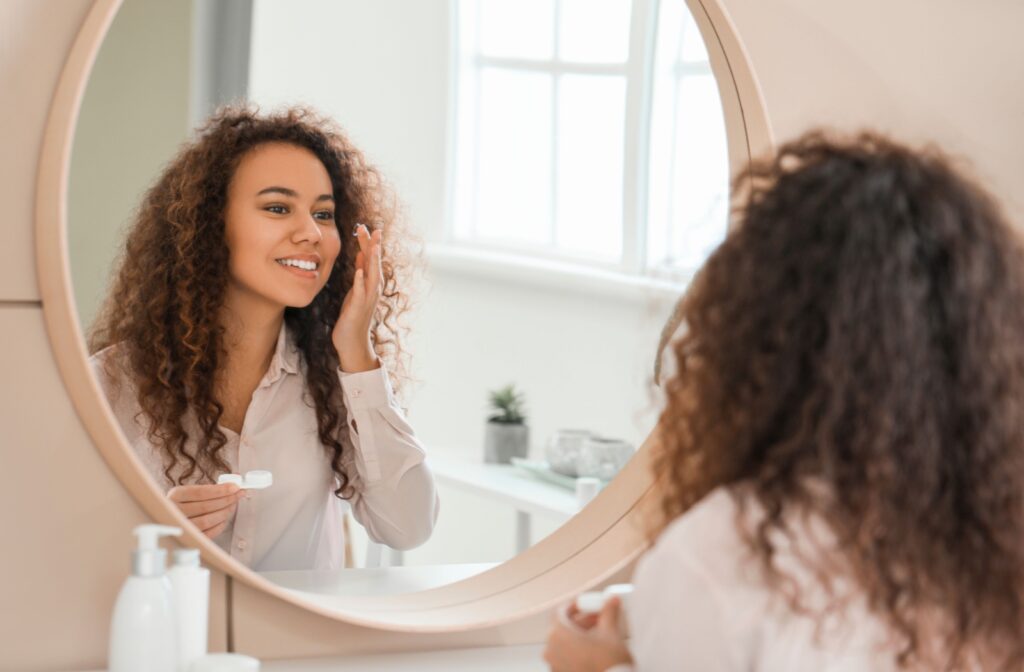Contact lenses provide an effective alternative to traditional eyeglasses, which many find more convenient for active lifestyles. Contact lenses work much the same way as glasses and correct refractive errors. The difference is that contact lenses rest directly on the eye, rather than in front of it.
For university students, contact lenses present particular advantages during lectures, laboratory work, sports activities, and social events. If you need glasses to correct your vision, contact lenses may be an alternative worth exploring.
What Are Contact Lenses?
Contact lenses are medical devices composed of biocompatible materials designed to sit directly on the eye’s tear film. The lens adheres to the tear layer through surface tension and the natural blinking motion, creating a stable optical system that moves with the eye.
Different Types of Contact Lenses
Contact lenses are categorized based on material composition, replacement schedule, and specific corrective functions. Understanding these categories helps students select the most appropriate option for their lifestyle and visual needs.
Soft Contact Lenses
Soft contacts are the most commonly prescribed type of contact lens. They’re manufactured from hydrogel or silicone hydrogel materials. Soft lenses conform to the shape of the eye, making them suitable for a wide range of refractive errors. They are the most comfortable for new wearers.
Rigid Gas Permeable (RGP) Lenses
RGP lenses are constructed from durable plastic materials that allow oxygen transmission while maintaining their shape. These lenses provide sharper vision correction for certain conditions, particularly astigmatism, and offer a longer lifespan compared to soft lenses.
Daily Disposable Lenses
Daily disposables are single-use lenses discarded after one wear. This option eliminates the need for cleaning solutions and reduces the risk of eye infections, making it ideal for students with busy schedules or those who occasionally wear contacts.
Bi-Weekly & Monthly Lenses
These longer-lasting contact lenses require regular cleaning and disinfection but offer cost-effectiveness for daily wear. These lenses are suitable for students who wear contacts consistently and can maintain proper hygiene routines.
Specialized Lenses
There are many types of specialty contact lenses, including toric lenses for correcting astigmatism, multifocal lenses for addressing presbyopia, and cosmetic lenses for enhancing eye colour. Each type addresses specific visual needs or aesthetic preferences.
How to Insert & Remove Contact Lenses
Proper insertion and removal techniques are essential for eye health and lens longevity. Each lens type may have a slightly different process, but the following steps are a general overview:
Insertion process:
- Wash your hands thoroughly with soap and dry with a lint-free towel
- Inspect the lens for tears, deposits, or inside-out orientation
- Place the lens on the tip of the index finger
- Hold the upper eyelid with one hand and the lower eyelid with the other
- Look straight ahead and gently place the lens on the eye
- Slowly release the eyelids and blink several times to center the lens
Removal process:
- Wash and dry your hands completely
- Look up and pull down the lower eyelid
- Gently slide the lens between your thumb and index finger
- Remove the lens with a slight sliding motion
- Clean and store the lens in fresh solution (for reusable types)
You should learn insertion and removal techniques specific to your brand and type of contact lens. During our comprehensive contact lens exams and fitting appointments, we’ll go over these strategies with you so that you can learn under professional supervision.

Can You Swim with Contact Lenses?
Swimming while wearing contact lenses poses significant health risks due to the potential for water exposure. All water sources, including swimming pools, hot tubs, lakes, and oceans, contain microorganisms that can adhere to contact lenses and cause serious eye infections.
A few of the risks associated with water exposure include:
- Acanthamoeba keratitis, a rare but severe infection
- Bacterial conjunctivitis from contaminated water
- Lens displacement or loss due to water pressure
- Chemical irritation from pool disinfectants
The safest option is to remove contact lenses before swimming and wear prescription goggles.
Eye Health Tips for University Students
University life presents unique challenges for maintaining optimal eye health while wearing contact lenses. Academic demands, irregular schedules, and social activities can impact proper lens care and eye hygiene.
Here are some recommendations for how to keep your eyes as healthy as possible:
Hygiene Practices
- Establish consistent cleaning routines regardless of schedule variations
- Keep backup supplies in dormitory rooms and study areas
- Use only recommended cleaning solutions, never water or saliva
- Replace lens cases every 3 months to prevent bacterial accumulation
Academic Considerations
- Carry lubricating eye drops for extended study sessions
- Take regular breaks from close-up work to reduce eye strain
- Always have an up-to-date pair of prescription eyeglasses with you
- Maintain adequate lighting while reading or using digital devices
- Consider daily disposables during exam periods to eliminate cleaning requirements
Lifestyle Factors
- Avoid wearing contacts during illness when your immune system is compromised
- Remove lenses before napping to prevent dehydration and irritation
- Limit wearing time during allergy seasons when tear production may be affected
- Schedule regular eye examinations to monitor prescription changes and eye health
Emergency Preparedness
- Keep backup eyeglasses available for contact lens problems
- Know the location of nearby eye care providers
- Understand warning signs that require immediate attention: persistent redness, pain, vision changes, or discharge
Important Considerations: Prescriptions & Online Purchases
While contact lenses offer convenience and flexibility, it’s important to understand that a contact lens prescription is not the same as an eyeglasses prescription. This is because contact lenses sit directly on the eye’s surface, whereas eyeglass lenses are positioned several millimeters away.
This difference in placement, though small, influences how your prescription is determined. A proper contact lens exam and fitting are essential to determine the correct lens for your eyes.
Additionally, purchasing contact lenses online without a valid prescription poses health and safety risks. Some websites may sell lenses without verifying prescriptions or sourcing from authorized manufacturers. Improperly fitted or counterfeit lenses can cause discomfort, blurred vision, corneal abrasions, and serious infections. To ensure your eye safety, always purchase lenses through licensed eye care providers or retailers who require a valid prescription.
Getting your contact lenses from your eye care professional not only helps protect your eye health but also ensures you’re wearing lenses suited to your unique vision needs and lifestyle.
Making the Right Choice for Your Vision
Contact lenses offer people with refractive errors enhanced convenience and visual freedom compared to traditional eyeglasses. The selection process should consider individual vision needs, lifestyle factors, and commitment to proper care routines. It is important that a licensed eye care provider ensures adequate vision and a proper contact lens fit for maximal success. A contact lens exam and fitting are an essential step for a new contact lens wearer. Call the professional team at Waterloo Vision Care Clinic today and book an appointment.




